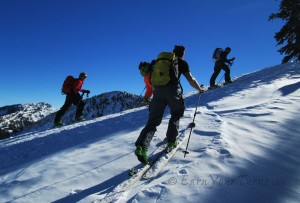Anyone who knows my quiver knows I am not fond of oversized skis, especially those whose waist has ballooned beyond 100mm. When forced I’ll accept another 10mm of blubber but only with a locked heel. That bias runs deep, so beware this review is an attempt to give enough information based on my experience and in spite of my perceptual handicap. Those who want fuller figured skis based need be careful how you interpret my experience with the Huascaran to see if it warrants a place in your quiver.
As a fat by width but skinny by weight type ski the Huascaran is a study in limits. On the uphill the weight is barely discernible from many skinnier skis because the requisite skins are wider too. Even so, that’s the major appeal of the Husacaran. Widebody float with moderate weight. Though it weighs by itself like it’s skin and bones it has some sinewy muscles to deliver a nice flex with a rebounding snap to launch you from turn to turn. This is particularly nice in all manner of soft snow, from mush to fluff, even crud as long as it isn’t riddled with frozen crust.
Fortunately I was able to experience how the Huascaran handled a variety of conditions on a tour between Big and Little Rottenwood Canyons, then back again. Most of the conditions were the kind I’d rather forget, but as with any backcountry tour, there were some occasional moments of really sweet snow when the Huascaran’s would start knocking out turns like they were dancing to a Mariachi band.
Unfortunately as soon as I could feel them responding to the rhythm, a frozen chicken head, or some crocodile crust would grab the tip of the ski and send it skittering to the side like a needle that skipped out of the groove and was headed off the turntable. Needless to say at moments like those I wished I were riding a heavyweight chop monster like a Kabookie that has more meat to punch back with. This is not to say the Huascaran can’t handle heavy snow, but it’s a whole lot easier to manage when it is consistent, which it wasn’t on that first tour in the Rottenwood Canyons. It took a few months before I had the chance to give the Huascaran’s a better opportunity to shine in the land of Sierra Cement. When it did, they picked up that Mariachi rhythm right where they had left off in the Wasatch, with smooth rebounding arcs down the mountainside.
Unlike many other powder planks, the Huascaran relies predominantly on the flex of the ski for its response, not funky, punky rocker. At 115mm at the waist, and a little rocker at either end, this ski rides long, and expects you to know how to flex and drive turns from the tip through the tail, not merely swivel your hips to bleed speed. In open terrain the Huascaran is big fun. In the trees you need to be on your game all the time. It may seem odd that I’m saying it isn’t much of a rockered ski and Dynafit promotes that it is. Forgive them their marketing indulgence. Dynafit’s definition of rocker is modest by alpine standards, but does help to make the ski more nimble in the trees and the early rise tip, even though subltle, breaks trail well.
Where the Huascaran fails to impress is where every super-fat ski fails – especially for tele, but even with training heels – on ice. There are precious few super fat skis that can compare to a mere fat or mid-fat ski for biting into icy snow. It just isn’t physically possible. Sure, you can hoooold an edge, and I did with the Huascaran on far too many occasions this past season. For an oversized, underweight fat boy the Huascaran did an admirable job of holding on, so if you’re on it and you run into those conditions, you’ll survive. However, that isn’t what it is made for.
As with all skis by Dynafit, it comes with a notch in the tip for Dynafit brand skins with the rubber rope at the tip and a notch in the tail for the tooth at the bottom of the skin. This makes it easy to rip the hide from tip to tail while you’re still in touring mode.
If you’re looking for a light weight, oversized fat ski to farm powder tracks mid winter, and like round, energetic turns you’ll want a pair of these in your quiver. Pick something skinnier for mornings on frozen corn.
Dynafit
Huascaran
MSRP: $800
| Length: | 167 cm | 177 cm | 186 cm | 196 cm |
| Weight: | 1690 g | 1780 g | 1850 g | 1940 g |
| Sidecut: | 133-110-122 mm | 134-112-123 mm | 135-114-124 mm | 136-115-125 mm |
Related Posts
Backcountry ski review: Dynafit Stoke
© 2013



5 pings